#conlang
Note
My apologies, what I meant is that most of your languages are made for fantastic, fantasy worlds, as opposed to a fictional culture on Earth. If you're creating a language for a culture set on Earth, you'd probably incorporate features that tie it to a real language, am I correct?
I think you still may be misunderstanding what the key questions are and how they factor into language creation. There are two questions:
Is this language supposed to be descended from an existing language (or set of languages) on Earth?
Is this language spoken by creatures that are identical to humans in all the ways that play a crucial role in language use, comprehensijon, and transmission?
These are the only relevant questions. Notice I didn't say anything about where the languages are spoken. That bit is irrelevant. Language has its own geography and it's the only geography that matters when it comes to a posteriori language construction.
For example, looking at Dothraki, the answer to (1) is no, and the answer to (2) is yes. For that reason, Dothraki should be a language that looks entirely ordinary, in terms of how it stacks up with languages spoken currently on Earth, but its vocabulary and grammar shouldn't be directly related to any language on the planet. How could it be, if our planet doesn't exist in that universe? But since Dothraki are completely ordinary human beings their language should be a compeltely ordinary human language.
If you look at the aliens District 9, the answers to both (1) and (2) are no, despite the fact that the movie takes place in South Africa. And, in fact, you see some very interesting linguistic phenomena in that movie, where you have two species that understand but cannot use each other's languages. Its setting, though, doesn't mean that the alien language should be influenced by Afrikaans in any important way, though. It may have "borrowings", but even those would be strange (calques, most likely), since the aliens can't actually make human sounds—the same way the humans wouldn't have "borrowings" from the alien language.
On the other hand, if you look at Trigedasleng, the answers to both (1) and (2) are yes. But the suggestion you seem to be making is that I might kind of haphazardly "borrow" features from an existing language into a language that I'm nevertheless creating from scratch. That wouldn't make sense. Trigedasleng is simply an evolved form of American English with some specific constraints (some quite unrealistic, due to the scifi setting) placed on the evolution. I didn't "incorporate" features from American English: it IS American English, through and through, evolved in a way that makes sense for the setting.
There are certainly a posteriori conlangs where the creator approaches the creation of the language by saying, "I took the initial consonant mutation of Irish and combined it with the triconsonantal root system of Arabic and added the Turkish plural suffix (with vowel harmony) and added the accusative from Esperanto", and the like. This is one of the hallmarks of an amateur conlanger. Not even a creole language in the real world does this. Creole languages draw influences from many different languages, but the resulting system can't be divided up neatly into different linguistic sources. Furthermore, the result is a coherent system that doesn't look like any of the sources. Tok Pisin gets a lot of its vocabulary and grammar from English, but also gets vocabulary from German and other languages that were native to the region. When listening to the language, though, it's not like it sounds like English, then it suddenly sounds like German for a word, then it sounds like a Papuan language, then back to English: the whole thing sounds like Tok Pisin. It's a seamless, coherent system—just like any language, since all languages on Earth have borrowings and features from other languages.
Also, minor nitpick: "real" language doesn't make sense. We say natural language vs. constructed languages. Both are equally real, in that neither has any kind of material existence. A constructed language is a real language with a fake history.
Does this make sense?
48 notes
·
View notes
Text

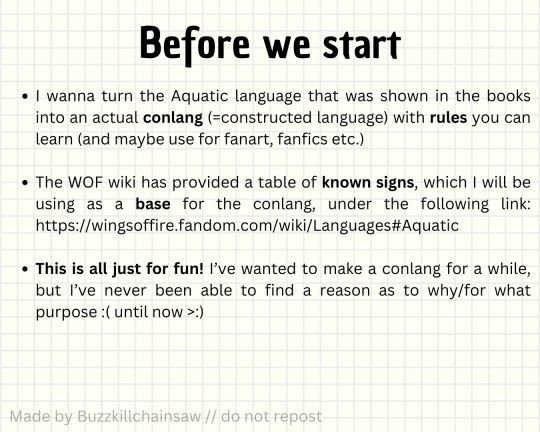

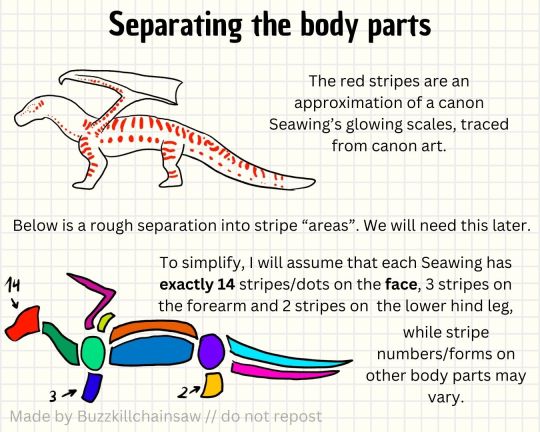


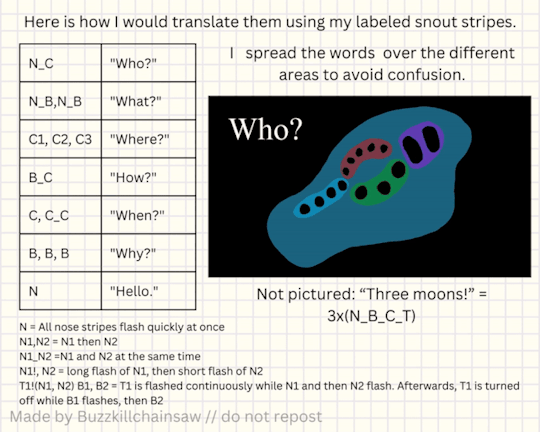
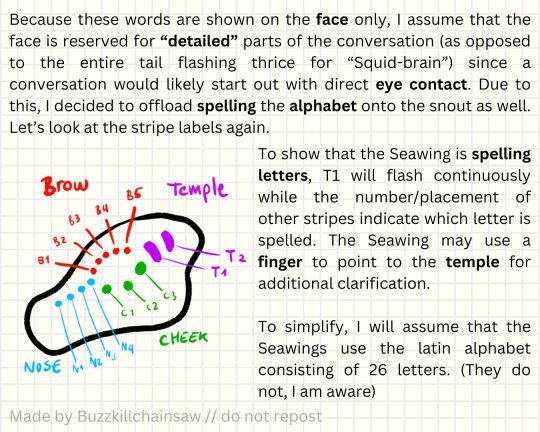
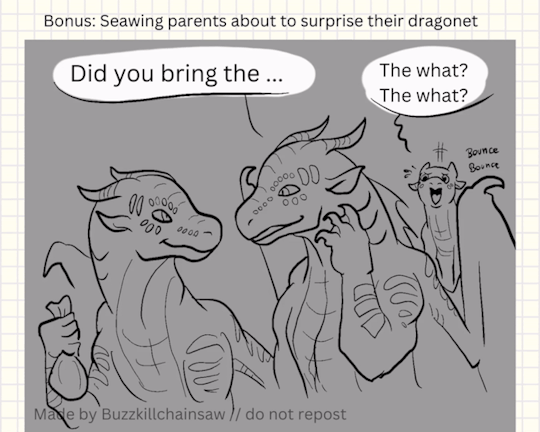
Yes I'm serious, no I'm not okay
(I'll be tagging this and further parts as #buzzkill aquatic so feel free to use that tag too if you use my aquatic expansion in your art/animations/fanfics etc)
Next part (tail edition):
#buzzkill aquatic#wof#wings of fire#seawing wof#wof seawing#seawing#aquatic#conlang#dragon#lore#worldbuilding
3K notes
·
View notes
Text
2K notes
·
View notes
Text
kind of obsessed with the conlang invented by 12th century composer and mystic hildegard von bingen. she called it lingua ignota and just sort of never explained why it exists or what it’s for? like. girl. why did you do this
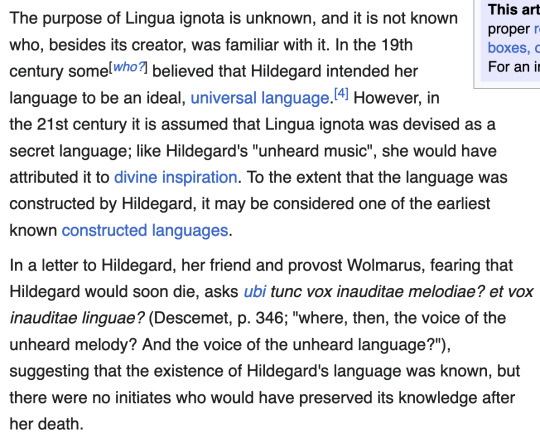


in case you're wondering what was up with her, like, in general, she was an abbess who was (1) politically influential, (2) chronically ill, and (3) plagued by visions.
but like seriously girl WHAT was the conlang for. TELL ME
#hildegard von bingen#did u know theres a bardcore artist called hildegard von blingen?#cw religion /#shaoniposting#conlang#linguistics#history
5K notes
·
View notes
Text
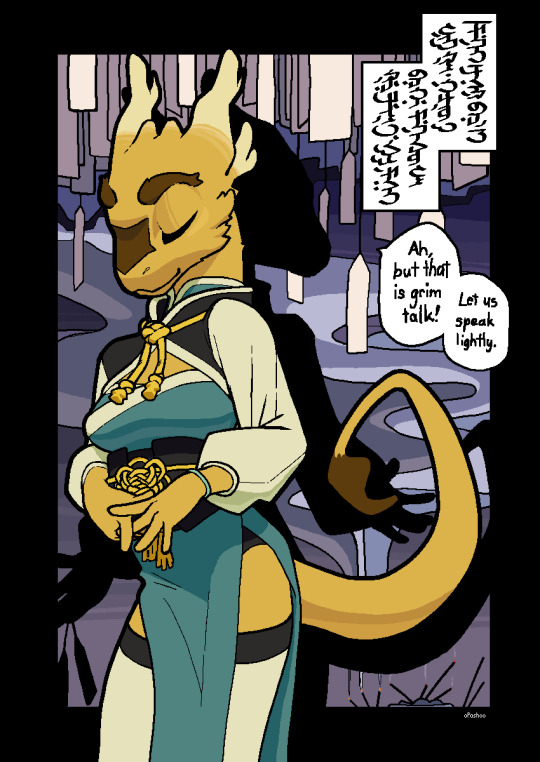
OCtober 2023: Shou, the Hidden Right Hand
A disillusioned fortune teller, scholar, and mystic, studied in old poems and proverbs. Their absent-minded demeanor belies a dangerous cunning and supernatural foresight with which they have cut down empires. Agent to a mysterious benefactor known only as "The Director".
Shou is nonbinary transfem (they/them)
The non-english text is in Caravan, a conlang I've been working on for about two years now. It reads from right to left:
"Hafii tokshj an, sa ejvo sheta-yjramea no / an im hafigaa eta shehn lumateh mu goro hjkkj."
There are monsters in the mountain, and we would seek shelter [from them] but / we will not find rest in the valleys.
EDIT: So I'm really indecisive and decided I really liked a dark background and no white outline, so I've replaced the original with that version. The original is below.

#OCtober#shou#kobold#transfem#nonbinary#amelieverse#pf2e#in pathfinder they are an#investigator#archaeologist#dnd#my art#Caravan#conlang#For those who have been there since the beginning of shou this is in fact their second redesign#trans
1K notes
·
View notes
Text
Oh also -
I got tired of making up my own inconsistent runes in pieces involving magic, so I made my own conlang alphabet!
I used to make these all the time when I was a kid (ty Artemis Fowl) and it was fun going back to that root.
Feel free to use/translate my latest pieces ♥
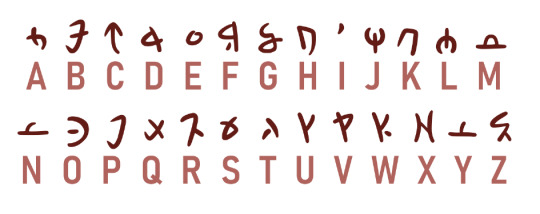
513 notes
·
View notes
Text
noticing as I learn different languages I tend to think using the shortest word from any of those languages, so for example instead of "this is" or "dette er", I'll just automatically think "c'est"
So my proposal is a creole of every language in which we find the shortest syllabic way to say every single word and speak at maximum efficiency
#toki pona is invited#toki pona#english language#language learning#language#conlang#langblr#french#norwegian
6K notes
·
View notes
Photo

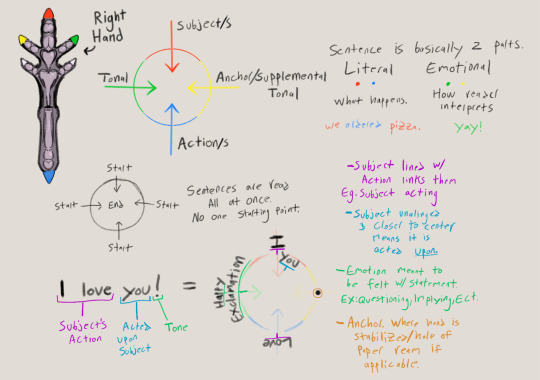
Wanted to figure out how chimera’s wrote and ended up starting on their written language proper. MASSIVE info dump below!
Writing
They write using four fingers of one hand, usually the right, coated in ink. Think like a stamp almost. The three middle fingers draw with the tips of the teeth whilst the thumb will alternate between tip and back. All words are written simultaneously inward. The remaining fingers grip the source of ink, usually a length of hardened pigment only wetted on one side OR those who write often could invest in a pen. A pen for a chimera is a fanning brush saturated with ink that the writing teeth brush through when needing to reink. It allows for much faster wetting of the teeth, but can be messy when learning or refilling.
Most chimera are right handed but left handed individuals exist, they will simply need to learn to use the two fingers opposite the middle in reverse of how someone who is right handed would! Luckily all fingers can move pretty independently of each other and it is an easy task. As chimera mostly communicate through direct broadcast most find the written word lacking, so it is a common occupation among Chimera to write for others. It is an impressive skill to eloquently convey ideas/feelings through writing. Though their language set up lends to it MUCH more than others.
The Nitty Gritty
All subject to change as this is very first drafty.
Chimeric is a logographic language, there is no set alphabet and all ‘words’ stem from symbols representing things and ideas. Sentences are kind of two sentences atop one another, with one being the literal and the other the reactionary. It is read from out to in and sentences are written in a circle divided into 4 quarters. We’ll start with the top moving counter clockwise.
Quarter 1 (Red) is the subject area, now subjects function the same as nouns for the most part, people, places, and things. But something important to note is that there must always be an ‘audience’ for the words being spoken. An audience basically means pronouns though they are a lot more encompassing with: I, You, Us, Them, Them excluding me/you, Us excluding you, Everyone, and a bunch of others. These are all acceptable audience subjects to top off your sentence. For instance you wouldn’t say “This pizza tastes good!” you would instead say “I enjoy the taste of this pizza” or “Everyone enjoys the taste of this pizza” the opinion/emotion needs to be applied to a source to make sense grammatically.
Quarter 2 (Green) is all about emotions and opinions. Chimeric language is an exchange of ideas but also importantly emotions and feelings. Q2 is dedicated to how the sentence is supposed to be interpreted or felt by the reader, as obviously in ‘spoken’ chimeric speaker and listener technically feel the same about what is currently being said. Listener opinion is very distinct from speaker and in writing the speaker takes priority. So for example the statement “Who finished the box but left it in the pantry?” would instead have to be translated into something akin to “I am pissed and questioning who had the audacity to finish the box and did not care enough to remove it from the pantry thus leaving me to find it and become disappointed?” Basically chimeric lends itself to very long translations due to their feelings.
Quarter 3 (Blue) is the action section of the sentence. The verbs if you will. This is where things are happening and is VERY tied in with Q1. Subjects in Q1 and Q2 will be linked together with lines that follow the same slice through the circle.
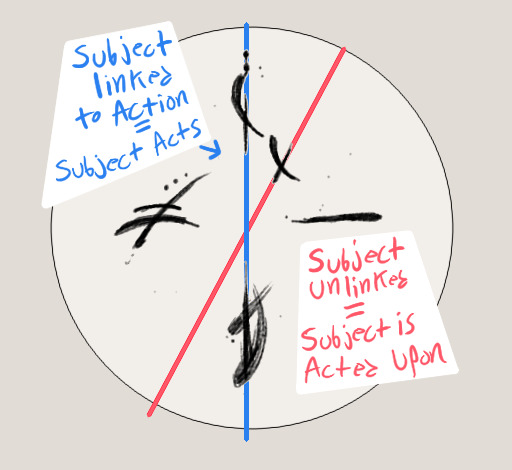
When a subject is linked to an action that means that the subject is the one performing the action, whereas subjects closer to the center and unaligned with an action are what is being acted upon. Like with the audience conundrum though an action needs a subject to actually act, whether it is an individual/s or an object or place. This is usually the least word heavy portion of the sentence as it is almost supplemental to Q1, and in contrast to the thin, crisp lines of the other quarters, Q3 will often be smudgey and more messy due to being written mostly with the back of the thumb.
Quarter 4 (Yellow) is generally not going to have any words written there, as it functions as the anchor point for the hand. The outmost finger rests here on the page to stabilize the hand as it closes during writing. When writing in a ream of papers this is where the hole to hold them all together is punched through. However in modern fanciful writing styles Q4 is also used as a secondary emotional quarter. This style will use Q4 as the reactionary emotion of the reader, more so the expected reaction and emotion from the reader. This is an EXTREMELY class based writing style and it is a GIANT NO NO to write like this for someone of higher status to read. Typically only Clan heads will freely use this writing style, especially towards each other lmao. The writing style of the passive aggressive power struggle.
All together Quarters are read at once! And I mean that there is no one word the chimera will start with. Every word of the sentence is absorbed at the same time, no following along a line like how I’m currently typing. But what indicates the order of which things are meant to be perceived is how close they are to the outside of the circle. Things closer to the center come later in the sentence and will be understood to be lower in the hierarchy of words. However only subjects and actions are directly linked to each other, emotion/opinion words are to have a more natural seep throughout the entirety of the sentence with only a loose idea of where they are to be felt. In this way while a subjects actions may be concrete, the writers feelings about them are more fluid and organic.
Chimeric conlang yay! I wanted to make modern Mirum script but decided I needed to start at the roots. So technically two written languages originate from Mirum, but they are extremely similar with one directly branching from the other. Chimeric is the original and Miran is the derivative, they mostly share characters but their sentence structure is different. Chimeric keeps the circular structure whereas Miran is a zigzagging horizontal and completely drops quarters 2 and 4. Leading to modern Miran being a very literal language vs Chimeric’s emotion heavy focus. But if you know one you can pretty much read the other, albeit with some culture shock.
#now i just have to make all the symbols hahaaha#chimera#mirum#conlang#worldbuilding#fantasy#language#chimeric#art#text#no true north
2K notes
·
View notes
Text
There should be a conlang community but for math. I wanna see counting with factorial base systems and people make up symbols for increasingly useless numbers. Maybe this can make some calculations more intuitive and others much more cursed.
712 notes
·
View notes
Text

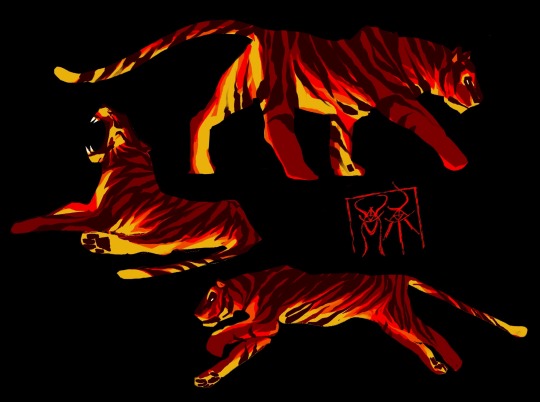



Tigers are solitary hunters with a presence in Firish folklore. They can quickly ascend trees by attaching their fire to trunks and shooting along them.
Firefowl pick at seeds and burning insects. They gather in small flocks with equal populations of males and females. The smaller and brighter burning males compete for mates through displays of their sustained, energy-intensive raised temperature.
A firefowl egg appears as a dense charcoal with an internal ember, which ignites and consumes the egg within days, forming a new fowl.
The Tsí’tsà’sh word for ‘boat’, êbshà, originates from the name given to the shape of a beetle’s shell. It’s an orange-color orange-fruit situation. Burning boats are named as such for their flecked elytra and two whirling antennae.
Red princes will occasionally emerge from the charred forests to roam villages. They are only rivaled in strength by the tigers.
The Firish horse is short and stocky. When not at work, it will graze and clear dried vegetation to allow for new growth.
692 notes
·
View notes
Text
I couldn’t take seeing that post an eighth time so I fixed it
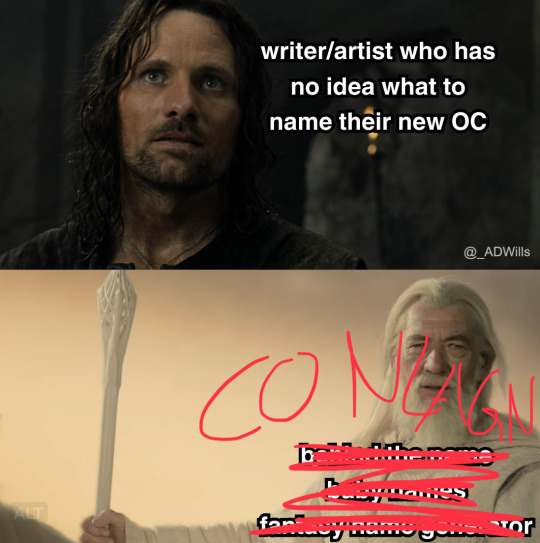
314 notes
·
View notes
Text
The Ts'íts'àsh (Firish) Language from Elemental
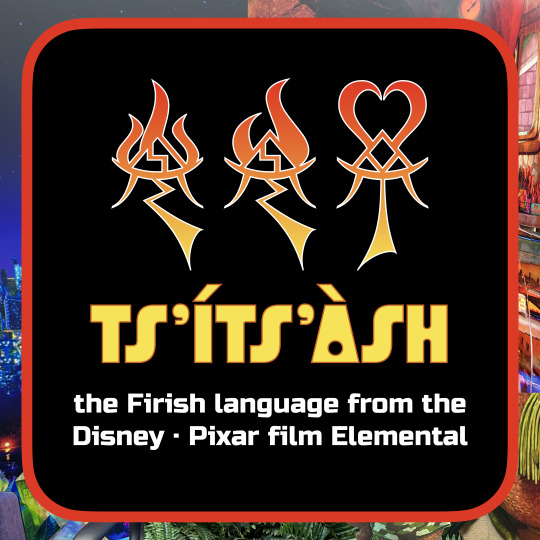

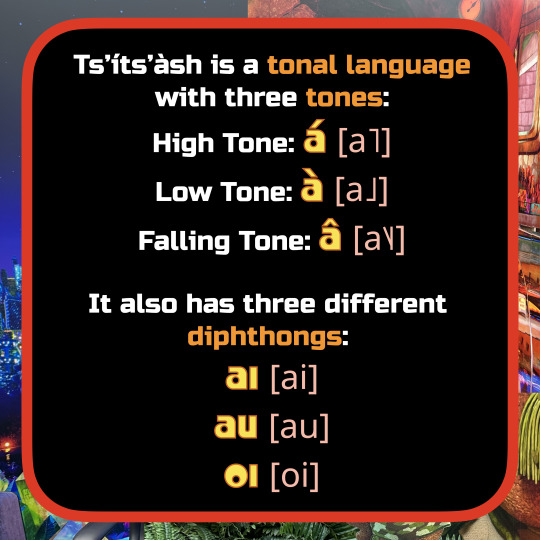


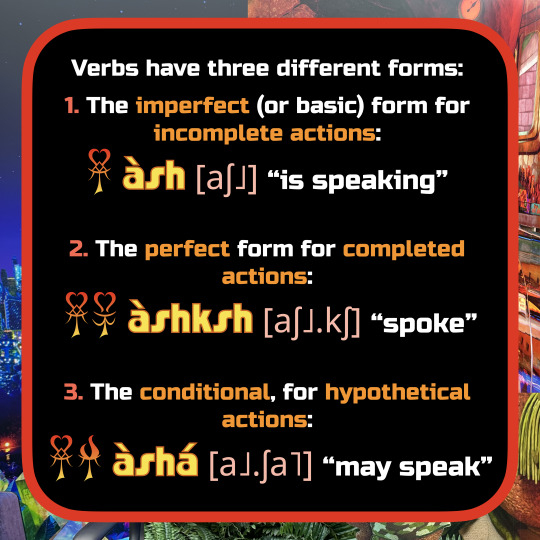

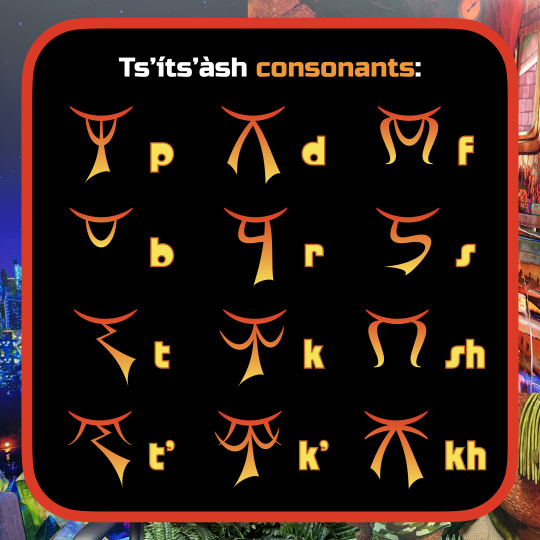


Ìf báì!
Jessie Sams (@quothalinguist) and I created a language for Pixar's latest film Elemental. We created both a spoken language and writing system that are used in spots throughout the film. It's out today, so if you watch it, see if you can spot any of it! We had a lot of fun creating a language the requested "sound like fire". A tough thing to do with a human mouth, but we had some fun with it! Some language highlights:
Ejective consonants
No nasals
Fricative nuclei
Fluid (ha, ha) case system
Glyphs that resemble braziers
If you check it out, we hope you enjoy it!
3K notes
·
View notes
Text
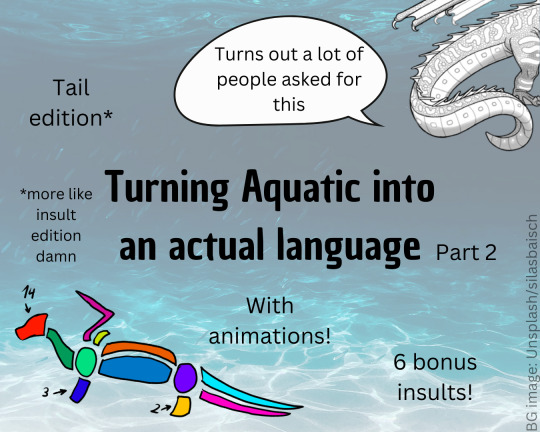




Tagging this and any previous/further parts as #buzzkill aquatic. Feel free to use that tag whenever you use my aquatic expansion in your own work (not mandatory)
975 notes
·
View notes
Text
ok ok i gotta share this with yall, not sure if this is common knowledge among ling nerds but if not the best site on the internet is ipa.typeit.org/full
it has almost every ipa symbol you could ever need, quick-access vowel, consonant, and diacritic charts for reference, shortcuts for everything that are easily learnable, and on windows, you can get the app to make the shortcuts work everywhere (the site works just fine too tho)
hella cool, go check it out, i promise i'm not sponsored or anything it's just been a lifesaver for me as someone who consistently has to type in ipa
261 notes
·
View notes
Text
Conlanger: technical, cringe, gives people actual information about what you do, "So you're like Tolkien?", only specific people know you're queer
Child of Babel: cool, mysterious, sinister, sounds like you're in a cult, what do you do? speak in tongues + do orgies probably, makes the right angry, "Do you worship Satan?", aura of gay homosex
#linguistics#linguistic#languages#shitpost#conlang#conlanging#constructed language#linguist shitpost#conlangs#conlang shitpost
484 notes
·
View notes
Text
HI HELLO! Welcome to my completely unnecessarily detailed analysis on how I think Inkfish languages could work! + with art! yay! This is all pretty rough and not fully fleshed out (I don't have the time or patience for that lmao). THIS IS A LONG POST.
Okay, so there's dozens of languages spoken by cephalopods in the Mollusc Era but the main two I'll talk about are Inkling (or Inklish) and Octarian, spoken mostly by Inklings and Octolings respectively.
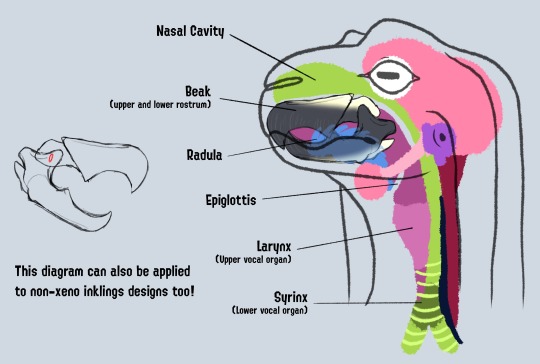
In cephalopods, speech is formed using the syrinx and larynx, two fancy vocal organs that most other species don't have together. The larynx makes sounds using the radula (tongue) and vocal folds in the throat, it's clear and pretty easy to understand as the sound itself resembles human speech, albeit warbled. The syrinx makes noise by vibrating air at the base of the trachea, it's often trickier to follow as it can sound more like droning background noise than words sometimes.
An inkfish can use both of them at once, resulting in an EXTREMELY complicated language system where words can be made up of multiple layered syllables, and several words and sentences can even be said at the same time.
As you can probably imagine, all of this is LITERAL HELL to learn for species who don’t have both a syrinx and a larynx (so basically anyone who isn't a cephalopod). But fear not! There are many simple and more inclusive alternatives, dialects and other cool stuff like sign language and instant TTS technology for people who physically can't pronounce Inkling/Octarian or even vocalise at all (eg. jellyfish).
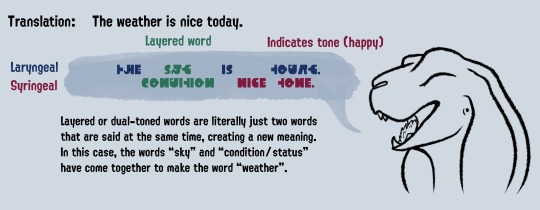
Both main Inkfish languages can be broken down into laryngeal words (made with the larynx), syringeal/drone words (made with the syrinx) or a combination of both, called dual-toned/layered words.
Keep in mind that both word-types can be spoken at the same time. Layering can be used to add additional connotations to a word, or to even make a new one entirely. For example, the laryngeal noun ‘bird’ combined with the syringeal noun ‘metal’ spoken together will create the layered Inkling word ‘aeroplane’, like a compound word in English.
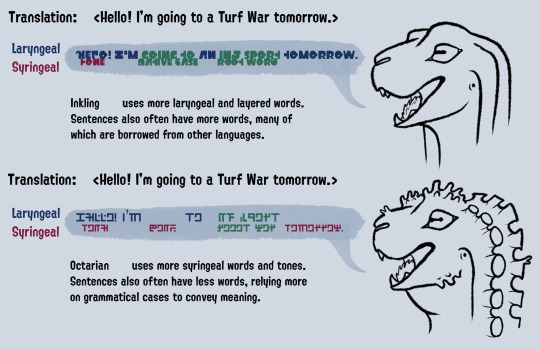
Dual-toned stuff is more common in Inkling than in Octarian, as the language is older and has more loanwords. Inklish's dependence on the larynx gives it a higher-pitched, clearer sound whereas Octarian's more monotone syrinx-based structure results in a deep, almost guttural sound.
Both cephalopod languages are heavy on tone and pronunciation, resulting in a plenty of accent indicators in written scripts. I used the in-game fonts for the art but if I were to rework it, each letter would probably be more complicated than traditional Mandarin on steroids. So hell on earth, basically.
On a side note, all of these language features open possibilities for some very cool poetry and literature. An inkfish author could write a poem with two lines of thought occurring at once, or a book with vivid emotional undertones written inside the prose. Pretty cool.
OKAY that's all I have to say thank you for reading! Hopefully this makes sense, feel free to send asks or whatever if it's confusing and I'll do my best to explain it better!
#I should go outside instead of analysing the silly squid game#I tried my best with my scientific and (limited) linguistic knowledge don't yell at me if I get something wrong lmao#my art#splatoon#xeno tag#xeno inkling#xeno octoling#splatoon 3#splatoon art#speculative biology#speculative zoology#conlang#splatoon headcanon#inkling#octoling#splatoon theory
570 notes
·
View notes